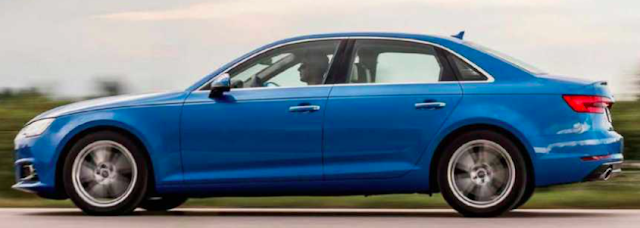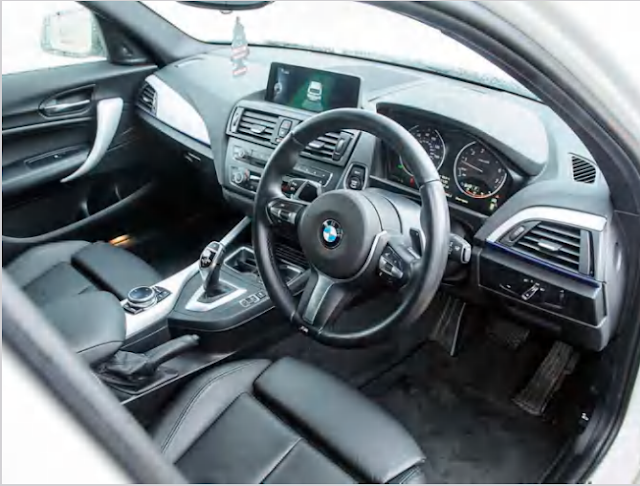latest installment
of Automobile’s Design of the
Year was almost too easy for us
to pick. The Ford GT was the
most exciting, most innovative,
and most surprising meant-for-
production car to make an
appearance in 2015, period. No
matter how you consider it—as
a front-line competition car or
a fabulous high-performance
coupe—Ford’s decision to
return to serious international
sports-car racing 50 years after
GT40s first showed up at Le
Mans was the biggest perfor-
mance-car news of the year.
The fact Ford sprung the new
GT on the world without the
series of concepts and
multiyear promises of “real
soon now”—as heralded the
Camaro’s return to market a
while back—is all to the credit
of the Blue Oval’s upper
management, whose silo-
centric methods were changed
radically by former CEO Alan
Mulally and carried on by
present incumbents.
You do not often see a whole new way of shaping a specific category of automobiles. Most new designs are evolutions or derivations of what came before, with little variations in details, maybe as simple as inte- grating separate trunks into the body form, as was done in the early 1930s, or adding fins to enveloping shapes, as was done to the point of absurdity in the ’50s. In grand touring cars, we’ve seen gorgeous road- capable racers like the Ferrari GTO and the Ford GT40 evolve into very exotic supercars like Koenigseggs and Paganis, all still very much in the same mold. Racing “sports cars,” like the incredibly efficient (but also insuperably ugly) Prototype racers that now fight for overall victory at Le Mans, have absolutely no visual linkage to anything any of us would want to be seen driving on the road. That’s not true for the new Ford GT.
Design Analysis
Svensson has moved around
the Ford world, spending three
years in Australia during one
stretch. He drives our kinds of
cars, too, with a Shelby GT350R
You do not often see a whole new way of shaping a specific category of automobiles. Most new designs are evolutions or derivations of what came before, with little variations in details, maybe as simple as inte- grating separate trunks into the body form, as was done in the early 1930s, or adding fins to enveloping shapes, as was done to the point of absurdity in the ’50s. In grand touring cars, we’ve seen gorgeous road- capable racers like the Ferrari GTO and the Ford GT40 evolve into very exotic supercars like Koenigseggs and Paganis, all still very much in the same mold. Racing “sports cars,” like the incredibly efficient (but also insuperably ugly) Prototype racers that now fight for overall victory at Le Mans, have absolutely no visual linkage to anything any of us would want to be seen driving on the road. That’s not true for the new Ford GT.
Design Analysis
1. Seen with the finned “cans” behind the lenses, the taillights look like something out of a 1930s Flash Gordon comic.
2. The “mustache” form in the rear is quite a bit more refined looking than the front one and integrates well into what is a very complex rear fascia.
3. The inside surface of the front fenders flows into a horizontal shelf on which the mirrors mount. The hard line continues into the tunnel where it fades to nothing.
4. This apparently hanging panel recalls the original BMW i8 concept car ... and some Formula 1 cars as well. It directs cooling air toward the front wheels and brakes and rests on the black under-nose extension as it wraps around the sides.
5. In June, I said, “This black band is the least aractive aspect of the overall design ...
a lile thick and less refined than the rest of the car.” I still think so.
6. The grille texture is coarse, and the whole opening seems very big. But who knows? It could be necessary to provide sufficient cooling to the turbocharged engine.
4. This apparently hanging panel recalls the original BMW i8 concept car ... and some Formula 1 cars as well. It directs cooling air toward the front wheels and brakes and rests on the black under-nose extension as it wraps around the sides.
5. In June, I said, “This black band is the least aractive aspect of the overall design ...
a lile thick and less refined than the rest of the car.” I still think so.
6. The grille texture is coarse, and the whole opening seems very big. But who knows? It could be necessary to provide sufficient cooling to the turbocharged engine.
Many of us have seen some
shots on the Web wherein the
GT is flanked by the very pretty
McLaren 650S, one of McLaren
design director Frank Stephen-
son’s best efforts to date, and
the beautiful Ferrari 458
Speciale. All three are great-
looking machines. Yet the Ford,
which is longer, wider, and
taller than its ancestor—from
which it is clearly influenced
with multiple points of
recognition artfully incorpo-
rated—also looks fresh. And
surprisingly, it manages to look
smaller than both the half-
century-old GT40, with its tiny,
typically British racing 95-inch
wheelbase, and Camilo Pardo’s
brilliant GT follow-up of a
decade ago, with 11.7 inches
more wheelbase and nearly
4 inches more height.
Chris Svensson, British-born design leader for the new GT (and all North American Ford products), attributes the impression of it being much smaller to the body’s very narrow central portion, which includes the nearly vertical exterior cabin walls. Amko Leenarts, Ford’s global director of interior design, insists the cockpit is certainly cozy but also generous enough in width for two people to be truly comfortable in the car. The two top designers are genuinely our kind of people. Svensson has been with Ford for 22 years, having launched his career with the Blue Oval in Cologne in 1992. One of his first big projects was the Ka, a minicar highly polarizing in its style. We ran a Four Seasons test of the Ka soon after it appeared, in anticipation of it coming to the U.S. I liked it very much, to the point of buying the test car and running it happily for a few years. Others hated the look.
4 inches more height.
Chris Svensson, British-born design leader for the new GT (and all North American Ford products), attributes the impression of it being much smaller to the body’s very narrow central portion, which includes the nearly vertical exterior cabin walls. Amko Leenarts, Ford’s global director of interior design, insists the cockpit is certainly cozy but also generous enough in width for two people to be truly comfortable in the car. The two top designers are genuinely our kind of people. Svensson has been with Ford for 22 years, having launched his career with the Blue Oval in Cologne in 1992. One of his first big projects was the Ka, a minicar highly polarizing in its style. We ran a Four Seasons test of the Ka soon after it appeared, in anticipation of it coming to the U.S. I liked it very much, to the point of buying the test car and running it happily for a few years. Others hated the look.














